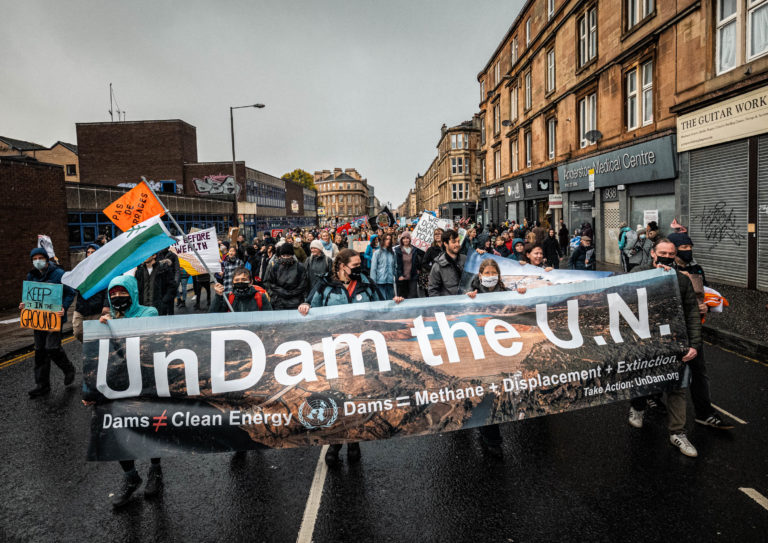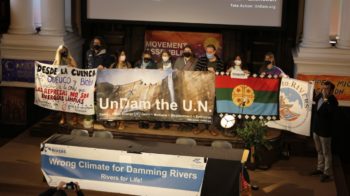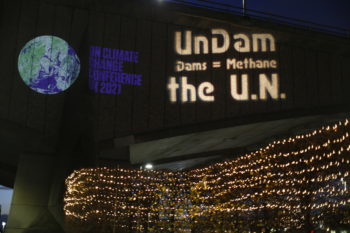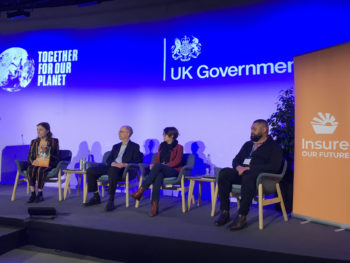COP26 – Fighting for protection of the world’s waters and a hospitable planet under an intensifying call to action for all humankind
By: Chris Wilke

It was an honor to represent the Waterkeeper Movement at COP26 in Glasgow, Scotland. It was an intense two weeks of collective advocacy, learning, networking, and negotiation, amid the heightened logistical, security, health, and safety protocols that are necessary for a major international conference in the time of COVID. Despite this challenge, this year’s COP took on a special urgency, as it came on the heels of an alarming IPCC Science Report indicating an increasing level of urgency for making real the previous commitments previously agreed to under the Paris Climate Agreement of 2016.
The COP itself is a sprawling event with many facets. The COP–or Conference of the Parties– is at once a global summit, a sustainability trade show, a science symposium, as well as a civil society advocacy platform. Close to 30,000 people attended this year’s event and it was a particularly challenging year with restrictions and safety measures.
Unfortunately, greenwashing and over-the-top sustainability marketing by business groups were evident from the moment we landed at the airport, and similar billboards demanded attention as we traveled across the town. This only intensified once at the COP. While it is nice to see business interests recognizing that their customer base cares about climate, it was staggering to see just how many were marketing their product as a “solution,” without any recognition of the immense and complex plight climate change poses for humankind.
Contrasting this empty optimism, negotiations between the parties were hampered by significant tension between developing countries already experiencing impacts of climate change in terms of droughts, flooding, superstorms, and sea-level rise vs. the global imperative of reducing carbon emissions. Should people in the developing world share the same level of sacrifice when many are just getting access to western conveniences like ownership of refrigerators and automobiles? Or does the harsh reality of climate math mean everyone must cut back, even those that had little to do with what got us into this mess? Do developed nations that objectively created the crisis owe a debt to help ease the climate struggles of impacted countries?
Inside the COP, we saw a mixture of gleeful optimism and paralyzing complexity. Outside the COP we saw impatience and anger at how empty rhetoric distracts from what may be our one remaining chance to limit the effects of the climate crisis.
Calling out false solutions

A primary objective of Waterkeeper Alliance at COP26 was to call out the dangers of hydropower development as a false solution to climate change and to demand that it not be considered for clean energy credits due to its impacts on living rivers, communities, biodiversity, and the inconvenient fact that new dams emit substantial amounts of methane from their reservoirs (methane is a potent greenhouse gas 86-times more potent than CO2). As a member of the Rivers for Climate coalition (with International Rivers, GegenStrömung, Water Climate Trust, and Rios to Rivers, along with Indigenous activists, scholars, filmmakers), we jointly conducted an event at the People’s Climate Summit on November 8, and presented a Global Declaration to the UN on November 9, demanding that the UNFCCC enter our objections as an official statement on the record. As we noted in our press release, the Declaration was signed by over 340 organizations from 78 countries. It was an honor to stand with Indigenous and community activists fighting dams in Manitoba, Labrador, Chile, and California as we presented the Declaration.
And, like tens of thousands of others in Glasgow, we also marched. Our coalition took a day off from the COP to join the Global Climate March, where we promoted our global petition to end climate subsidies for hydropower. The coalition also collaborated on a cool light projection event with Backbone Campaign to draw additional attention to the false promises of the hydropower industry. There was a different energy in the streets than inside the COP and it was clear the two elements were not in sync. Inside the COP, we saw a mixture of gleeful optimism and paralyzing complexity. Outside the COP we saw impatience and anger at how empty rhetoric distracts from what may be our one remaining chance to limit the effects of the climate crisis. Despite the seriousness of the issue and the energy and impatience of the crowd, people were very peaceful and we saw no confrontations with police during the various marches, rallies, and protests that seemed to only gain in intensity as the two-week period unfolded.

Accelerating the Transition from Fossil Fuels
Climate math advances a simple imperative: we must make rapid and deep cuts to fossil fuel use. A key strategy to reverse this unsustainable course is removing direct investment in, and insurance underwriting for, dirty fossil fuel projects. To highlight the important role of the insurance industry in this regard, the Insure Our Future Coalition—of which we are a member—released its much-anticipated annual insurance industry climate scorecard during COP26. In this 5th Scorecard, researchers identified industry “leaders and laggards.” The report shows that most American companies like Travelers, Liberty Mutual, and AIG lag far behind European counterparts like Allianz, AXA, and Zurich, which are leading the way on divestment from the dirtiest fossil fuels, like coal and tar sands.
However, the report also shows that everyone still has a long way to go in divesting from conventional oil and gas. Unfortunately, oil and gas companies are still developing new oil and gas fields, which—according to IPCC and IEA—would put the world on a path for temperature changes well above 1.5˚ or 2˚C. These numbers represent the upper limit of change before runaway catastrophic impacts impact human society and biodiversity.

Outcomes of COP26
COP26 will be most remembered for the agreement reached among the parties on the day after closing ceremonies. The Glasgow Agreement represented progress toward aspirations first voiced in the Paris Agreement that came out of COP21 in 2016. But despite some bright spots, the parties failed to produce a detailed and binding roadmap to hold climate change to 1.5˚C. “Keep 1.5 Alive!” was the rallying cry that kept negotiations going, even during a staged march out of the COP on the final day, to show solidarity with the building impatience in the street. You could feel the energy and determination from those working on the global agreement, but most experts agree we fell short of the goal, and if it is still alive, 1.5˚C may only be a glimmer that is fading fast. Much more work needs to be done. With each passing year technology and determination may continue to improve, but time is clearly running out. In the meantime, Waterkeeper Alliance, our many Waterkeeper groups, and our partners and allies will continue to fight for building resilience in our watersheds and a just transition to a low carbon future.
Diving Deeper – Daily Waterkeeper Video broadcasts from COP26
Waterkeeper Alliance was proud to partner with Collier County Waterkeeper and Kissimmee River Waterkeeper on daily broadcasts over Zoom and social media from the COP. In 13 nightly episodes, we covered the events of the day and interviewed participants at the COP as well as Waterkeepers around the globe. Special thanks to our co-hosts, Waterkeepers KC Schulberg (producer), and John Capece as well as the production crew and all the Waterkeepers that joined the broadcasts.